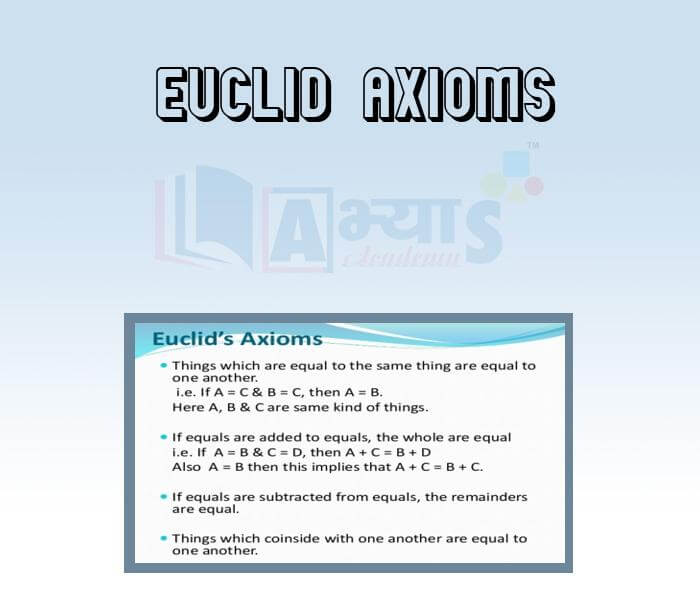Euclid Axioms

Euclid Axioms
Euclid's Axioms:
Starting with his definitions, Euclid assumed certain properties, which were not to be proved. These assumptions are actually ' obvious universal truths' . He divided them into two types: axioms and postulates. He used the term 'postulate' for the assumptions that were specific to geometry. Common notions (often called axioms), on the other hand, were assumptions used throughtout mathematics and not specifically linked to geometry. Now -a- days 'postulates' and 'axioms' are terms that are used interchangeably and in the same sense. 'Postulates' is actually verb. When we say " let us postulate", we mean, "let us make some statement based on the observed phenomenon in the Universe". Its truth/ validity is checked afterwards. If it is true, then it is accepted as a 'postulate'.
A system of axioms is called consistent, if it is impossible to deduce from these axioms a statement that contradicts any axioms or previously proved statement. So, when any system of axioms is given, it needs to be ensured that the system is consistent.
After Euclid stated his postulates and axioms, he used them to prove other results. Then using these results, he proved some more results by applying deductive reasoning. The statements that were proved are called propositions or theorems. Euclid deduced 465 propositions in a logical chain using his axioms, postulates, definitions and theorems proved earlier in the chain. In the next few chapters on geometry, you will be using these axioms to prove some theorems.
Students / Parents Reviews [10]
My experience was very good with Abhyas academy. I am studying here from 6th class and I am satisfied by its results in my life. I improved a lot here ahead of school syllabus.

Ayan Ghosh
8thIt has a great methodology. Students here can get analysis to their test quickly.We can learn easily through PPTs and the testing methods are good. We know that where we have to practice

Barkha Arora
10thMy experience with Abhyas academy is very good. I did not think that my every subject coming here will be so strong. The main thing is that the online tests had made me learn here more things.

Hiya Gupta
8thAbhyas is a complete education Institute. Here extreme care is taken by teacher with the help of regular exam. Extra classes also conducted by the institute, if the student is weak.

Om Umang
10thIt was a good experience with Abhyas Academy. I even faced problems in starting but slowly and steadily overcomed. Especially reasoning classes helped me a lot.

Cheshta
10thA marvelous experience with Abhyas. I am glad to share that my ward has achieved more than enough at the Ambala ABHYAS centre. Years have passed on and more and more he has gained. May the centre flourish and develop day by day by the grace of God.

Archit Segal
7thOne of the best institutes to develope a child interest in studies.Provides SST and English knowledge also unlike other institutes. Teachers are co operative and friendly online tests andPPT develope practical knowledge also.

Aman Kumar Shrivastava
10thI have spent a wonderful time in Abhyas academy. It has made my reasoning more apt, English more stronger and Maths an interesting subject for me. It has given me a habbit of self studying

Yatharthi Sharma
10thAbhyas Methodology is very good. It is based on according to student and each child manages accordingly to its properly. Methodology has improved the abilities of students to shine them in future.

Manish Kumar
10thIt was good as the experience because as we had come here we had been improved in a such envirnment created here.Extra is taught which is beneficial for future.









